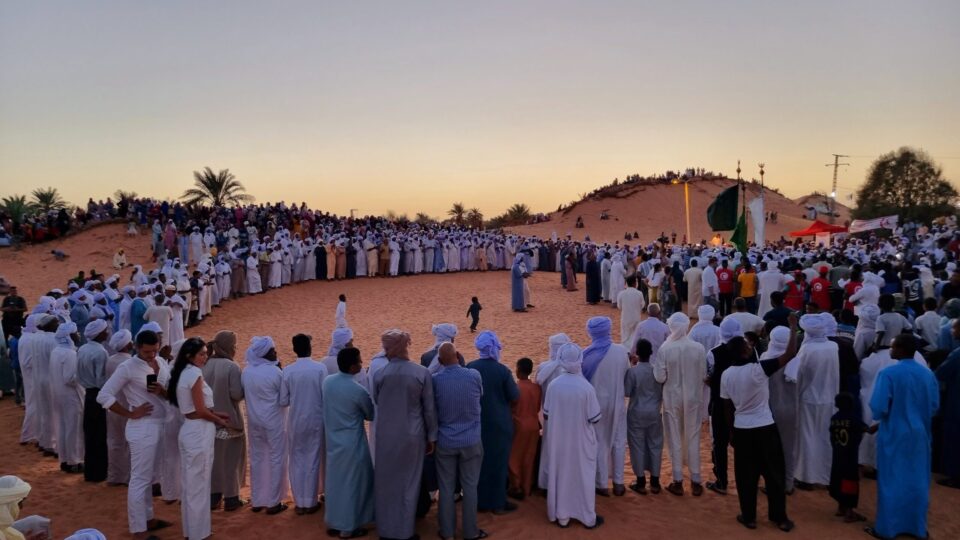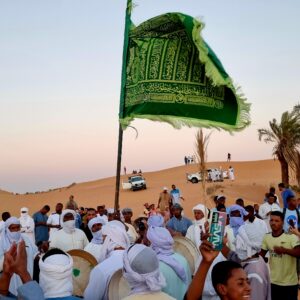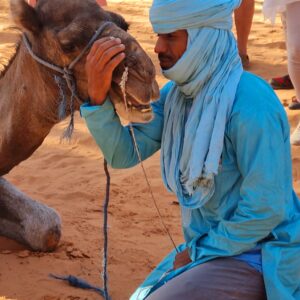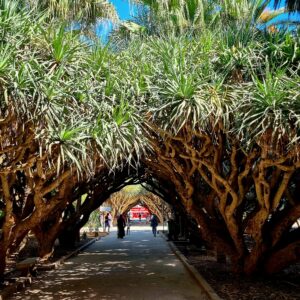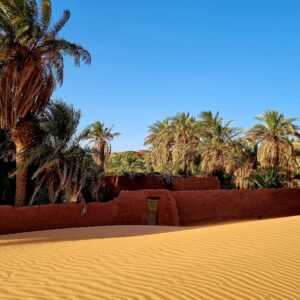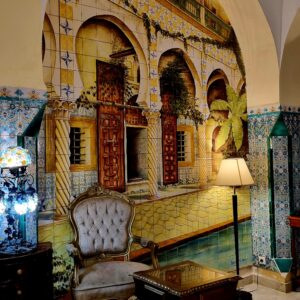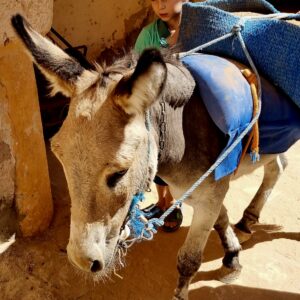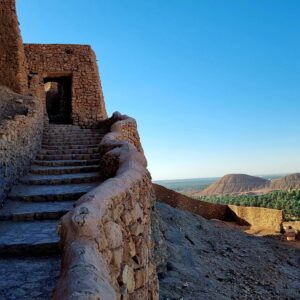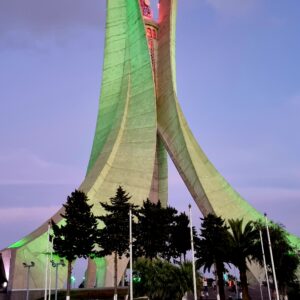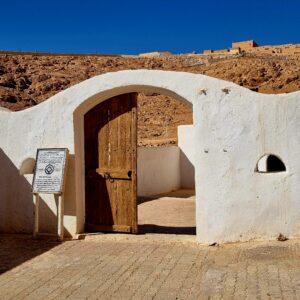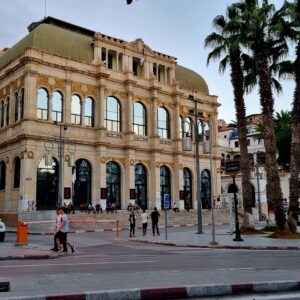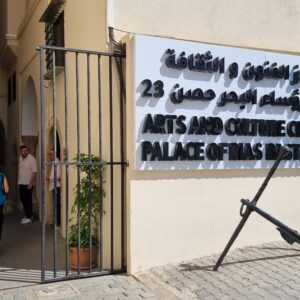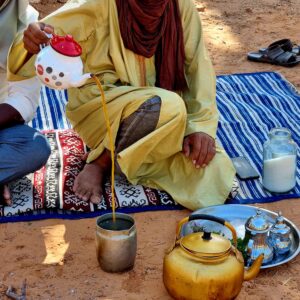Tourism in Algeria is still in its infancy, and the government is doing everything to open up the country to foreigners and allow them to visit in greater numbers and get to know its beauties.
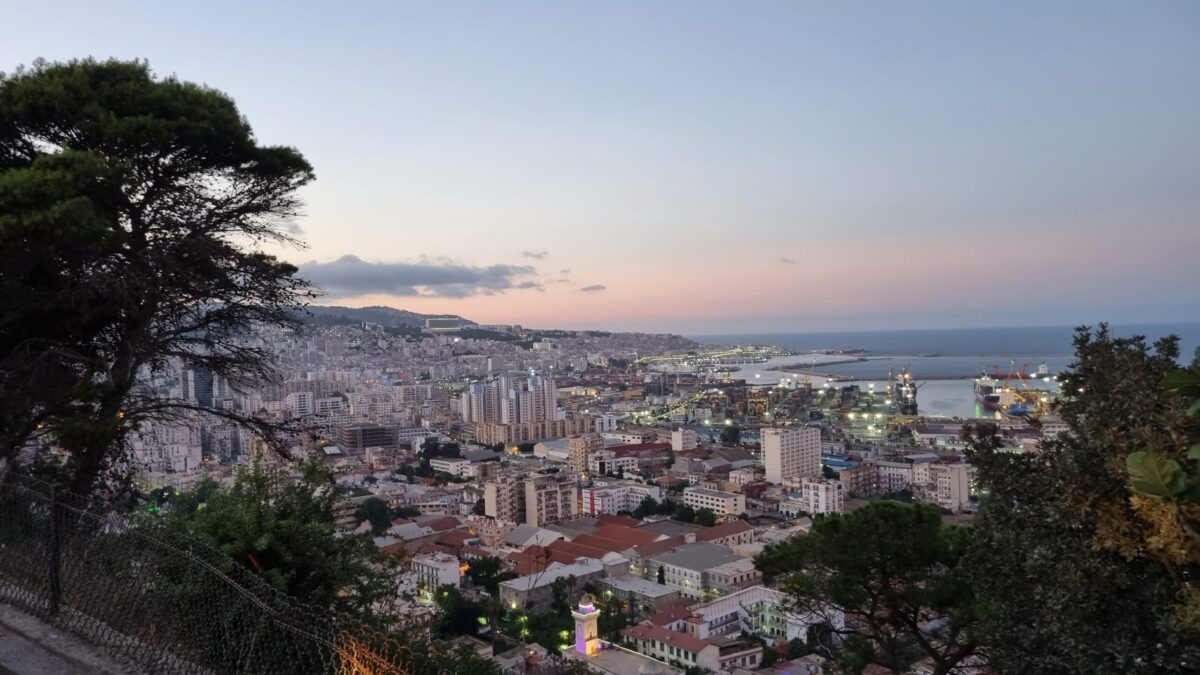
At the invitation of the Embassy of Algeria, the editorial staff of Diplomacy&Commerce Magazine had the opportunity to visit Algeria and attend the SITEV Tourism and Travel Fair held there, as well as to learn about the tourism potential of this North African country.
Despite its extraordinary potential, Africa’s largest country by area is not known in Europe as a tourist destination. A large part of the Sahara desert is located in Algeria, and it is the tourists’ first association when this country is mentioned, but apart from desert tourism, one should not overlook the beautiful Mediterranean coastline with a number of interesting cities and resorts.
Our group, which included journalists from a dozen European and African countries, had the opportunity to get to know the capital of Algeria but also to venture deep into the desert to the unofficial capital of the Sahara, the city of Ghardaïa, and the large tourist centre of Timimoun in the far southwest of the country.
One of Algeria’s greatest sights, the Tassilli National Park in the southeast, along the border with Tunisia, remained an unfulfilled wish and a great reason to revisit this country.
According to data from the World Tourism Organisation (WTO), Algeria, while not considered a tourist superpower, still ranks fourth in Africa regarding the number of foreign visitors. The main contributing factors are the arrivals of Algerians from Europe, primarily France, and visiting tourists from neighbouring Tunisia.
And while it is not overrun with foreigners, this beautiful country is buzzing with local tourists, who most certainly love to travel and get to know its beauties.
When discussing the state of tourism in Algeria, one can’t avoid the lack of tourism infrastructure. This doesn’t apply so much to roads and airlines, which are plentiful in domestic transport, due to long distances and isolated oases and cities in the desert, but rather to the lack of professional staff working in tourism. That is why a tourism fair like the SITEV takes place in the capital. It is a unique opportunity for tourism professionals to meet in one place and exchange their experiences and knowledge.
The famous Zinedine Zidane has also joined in the promotion of tourism
However, there is still a lot to do to increase the number of foreign tourists. The Ministry of Tourism has recognised this and is working diligently on that project, and bringing over foreign journalists for so-called Eductours has become a tradition already yielding results. The famous Zinedine Zidane has also joined in promoting tourism as part of advertising campaigns. There is also a growing interest in Algeria within Serbia. In a conversation with the ambassador of Algeria, H.E. Fatah Mahraz, we learn that citizens’ associations in Serbia nurture friendship with Algeria and organise group visits to this country for their members. There is a growing interest among our tour operators as well, which has influenced the decision of the Algerian national airline to include a direct route between Algeria and Belgrade in its plans. This route is already in the works, and the ambassador confirms that negotiations will soon begin with local aviation authorities regarding establishing regular traffic.
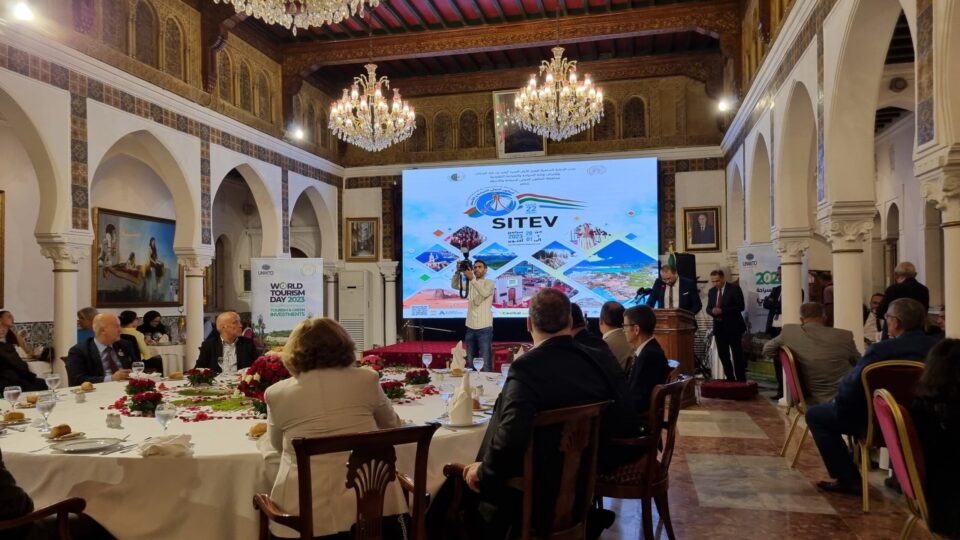
Unfortunately, bureaucratic procedures remain an obstacle to the mass arrival of tourists for a while longer. Citizens of Serbia need a visa to go to Algeria, which can be easily obtained at the consular department of the Algerian embassy in Belgrade. Still, Algeria’s bureaucracy can further complicate and slow down the movement of tourists.
Tourist groups can’t move freely around Algeria because parts of the country are considered unsafe due to potential incursions by terrorist groups across the southern borders. Fortunately, these risk zones are restricted to 200 kilometers from the border and don’t include any tourist attractions. It is encouraging that the rest of the country is perfectly safe, as any good-intentioned visitor will quickly find out.
Algerians are very friendly and kind, very happy to socialise with foreigners and host them in a traditional and very hospitable way, always with a cup of invigorating tea and plenty of food. Right from our first step in the capital, we could see that this country is open to foreigners, proud of its traditions, and eager to share and show them to its guests.
A walk through the capital must start from the famous Casbah, the old city on top of the hill above the port. At the top, there are the remains of the fortress and city walls, enclosing white and ochre clusters of small, dilapidated houses built mostly of earth and mud and extending down the hillside towards the sea. Although under the protection of UNESCO as World Cultural Heritage, the Casbah is in a rather bad state due to the materials it was built from, the year of construction, the effect of sea salt in the air, winds, and earthquakes. Almost a fifth of all buildings were completely demolished, and in those places, there are now either empty lots or ruins, while one-fifth of the remaining 1800 buildings are in a bad state. Only one-tenth of the buildings are structurally protected from collapse. Many houses are abandoned, and squatters can often be found in them, hindering the Casbah’s further reconstruction. Despite this situation, the city of Algiers and the state are working intensively on the Casbah’s revitalisation and investing significant funds in the reconstruction of both buildings and public spaces. The old city’s atmosphere hasn’t been disturbed, and visitors will get an opportunity to have an authentic experience while wandering through the extremely narrow streets and meeting the locals who are going about their daily business. Numerous national cuisine restaurants are located in the Casbah, so tourists can relax in a traditional Algerian townhouse setting to try local specialties based on couscous, chicken, or lamb.
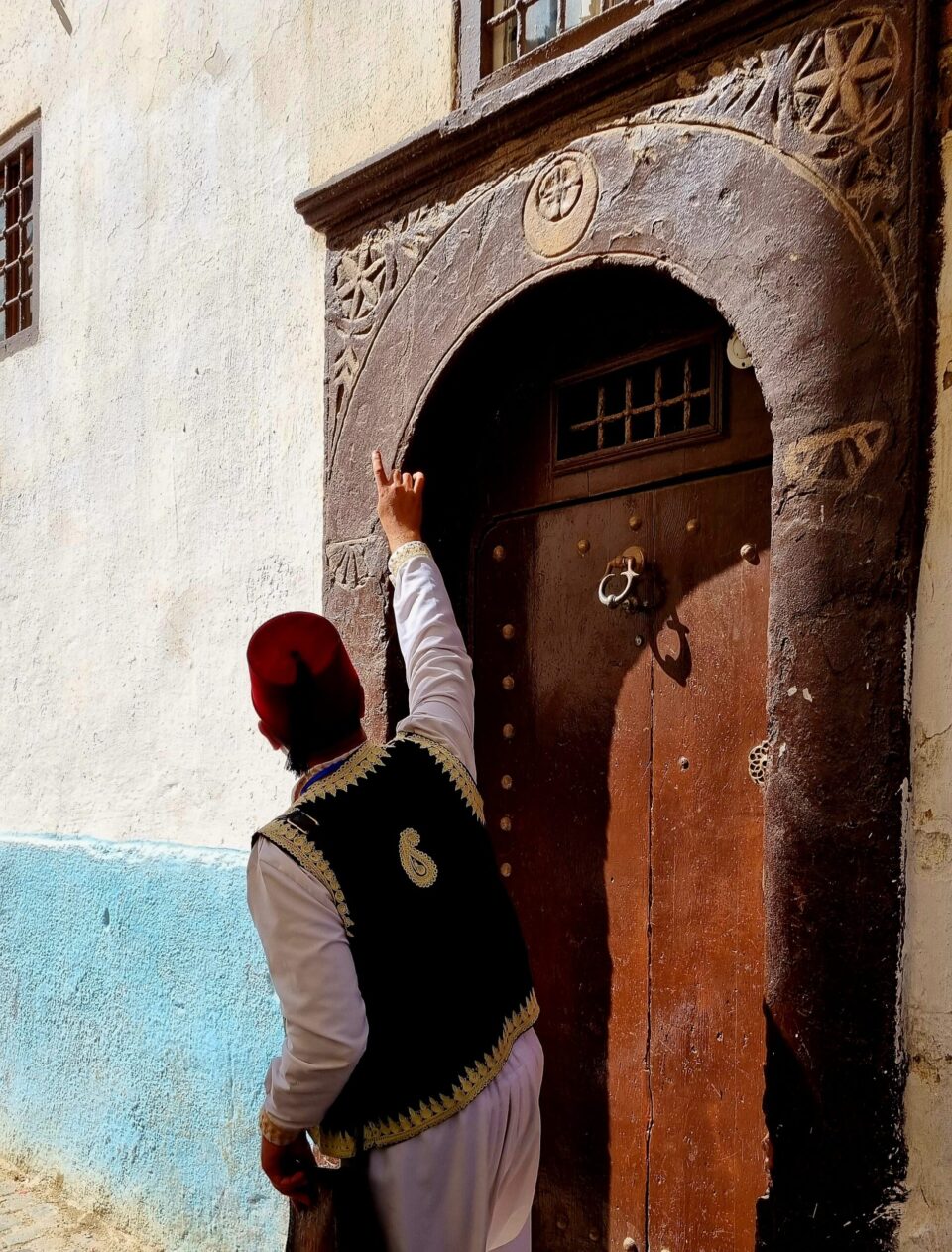
Descending from the Casbah to the Place des Martyrs, you enter the modern part of the city squeezed into a narrow strip along the coast of the Mediterranean Sea. City palaces resembling those in Paris or Marseille frame rectangular squares full of tall palm trees with lush canopies creating a shade. Faucets, fountains, and flowerbeds provide a pleasant environment for the street vendors offering various sweets, water, and refreshments as they trade all day long with the hurried workers who crowd the buses and the modern subway or move hastily along the wide boulevards such as the one named after Ernesto Che Guevara.
The Latin American revolutionary is very popular in Algeria, and we even found out at the hotel where we were staying that he had also stayed there once. Left-wing ideology and anti-colonialism are still strongly represented in this country, which only achieved freedom from French colonial rule in 1962. The historic Hotel El Djazair (Arabic name for Algeria) is a well-known colonial building. It used to be called Hotel Saint George, and today, a taxi driver is more likely to bring you to the right place if you tell him the hotel’s old name.
In the centre of the city, you will find the Rais Palace, also known as Bastion 23. This complex of buildings, some of which date back to the early 16th century, now houses the Arts and Culture Centre, and visitors can see what the palaces looked like throughout history.
A favourite meeting place is on the hill south of the city, where there is a monument dedicated to the Algerian War, which was fought for independence from France between 1954 and 1962. This monument symbolizes the city, dominating it so it is visible everywhere. It appears to have three palm leaves joined together, with the statues of Algerian soldiers resting at the base and an eternal flame in the middle. The promenade around the monument offers a spectacular view of the city and the harbour below it.
Algerians are very friendly and kind people, very happy to socialise with foreigners and host them in a traditional and very hospitable way, always with a cup of invigorating tea and plenty of food
The desert capital
After an hour’s flight from the country’s capital, you reach the capital of the Sahara – the informal one, of course. Ghardaïa deserves that nickname as it is the region’s most important commercial and cultural centre. Its streets are crowded with people visiting the local market and shops. It is situated in a large oasis in the M’zab River valley. The whole valley is a dried-up riverbed (wadi) that rarely fills with water during the rainy season. In the centre of the oasis is Ghardaïa, its bustle, and dynamism far surpassing a city of less than one hundred thousand souls. The city is a mini-metropolis, consisting of several villages and small towns dotted around the centre and scattered throughout the oasis. The residents of these villages head to the city for everything they need. In one such village, El Atteuf, under the protection of UNESCO, we came across a real traditional commune.
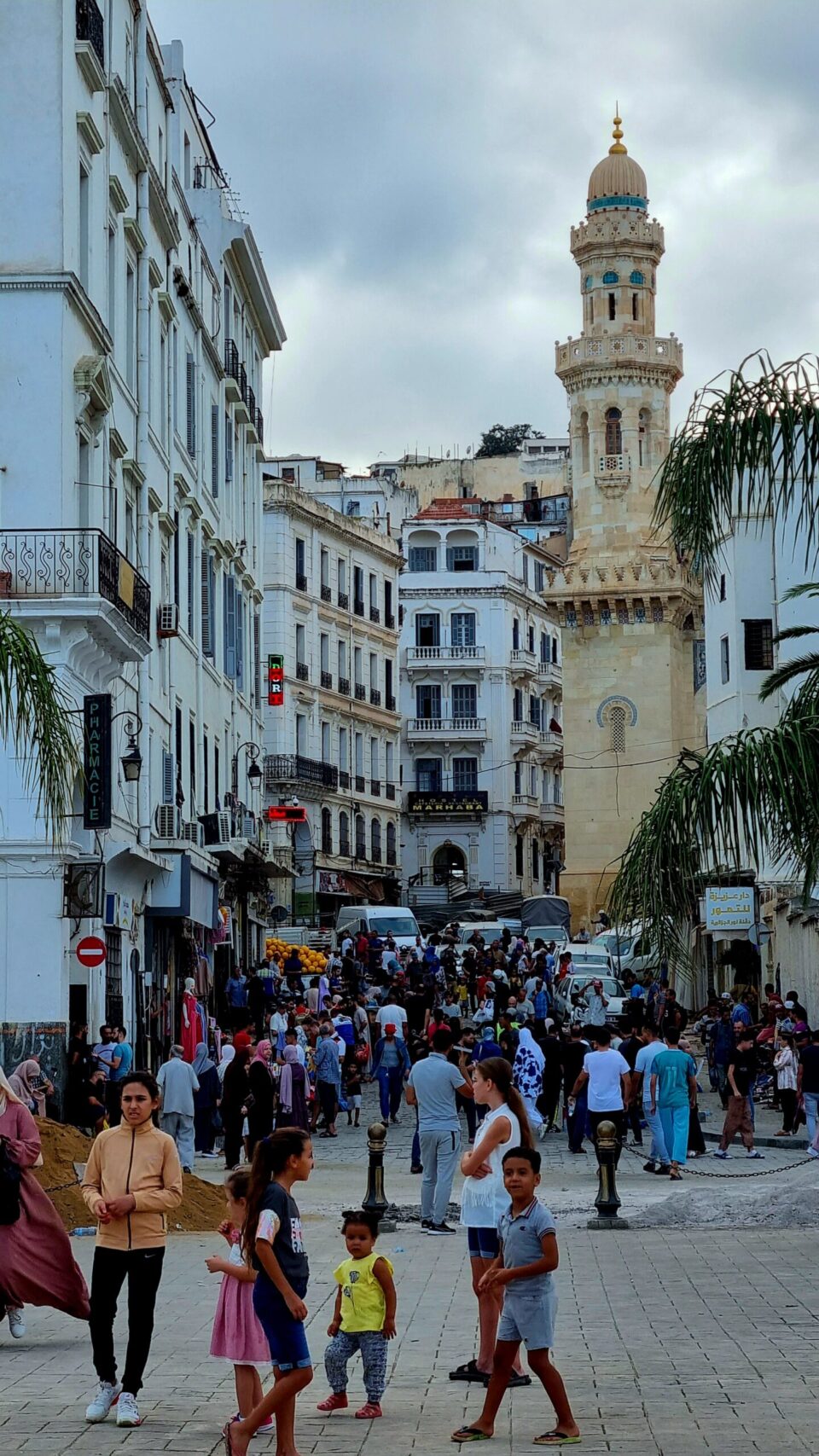
Strolling through the old centre of the village, along winding streets between houses built of sand and mud, we got to know an unusual society and learned a lot about the life of the local population. In a village like this one, there is no state administration. Rather, it is governed by an informal council of wise men and respected villagers. The residents elect particularly honourable and capable individuals from among themselves, assigning them responsibilities and areas of activity. Thus, there is a person in charge of “urban planning.” That respected resident will always be invited to give his opinion, judgment, and recommendation when something new is being built in the village. He ensures that no house exceeds a height of seven meters because all residents, no matter how rich they are, have the right to sunlight. Basic groceries and various household items are free, and their exchange occurs at the village market on the main square. Walking through the old streets, we come across numerous wells shared by the entire commune. All public works are cared for by the residents equally, according to their abilities. The children help as much as they can, and you can often see them squealing and screaming as they play while chasing a donkey burdened with some load. Women don’t have to work, but they can if they wish.
He makes sure that no house exceeds a height of seven metres, because all residents, no matter how rich, have the right to sunlight
The whole village organises weddings and celebrations, and everyone is in charge of something so that the newlyweds and their families have no expenses. They are guests of honour at their celebration, which brings together all the villagers and can last for days.
Most Ghardaïa residents are Berbers, who bury their dead in unmarked graves so that everyone who comes to the cemetery would pray for all the dead, not just their own. It seems that this extraordinary example of togetherness also continues in the afterlife.
Lunch in the Oasis
On our way further south, we take a break in an oasis where we have a traditional lunch under a tent with carpets spread out. We sit on the floor at low tables, and the hosts first serve us dates, then bring out soup, couscous with meat and vegetables, and fruit. Those who wish can ride a camel after lunch, while the others drink strong and sweet tea to refresh themselves before continuing the long drive even deeper into the desert.
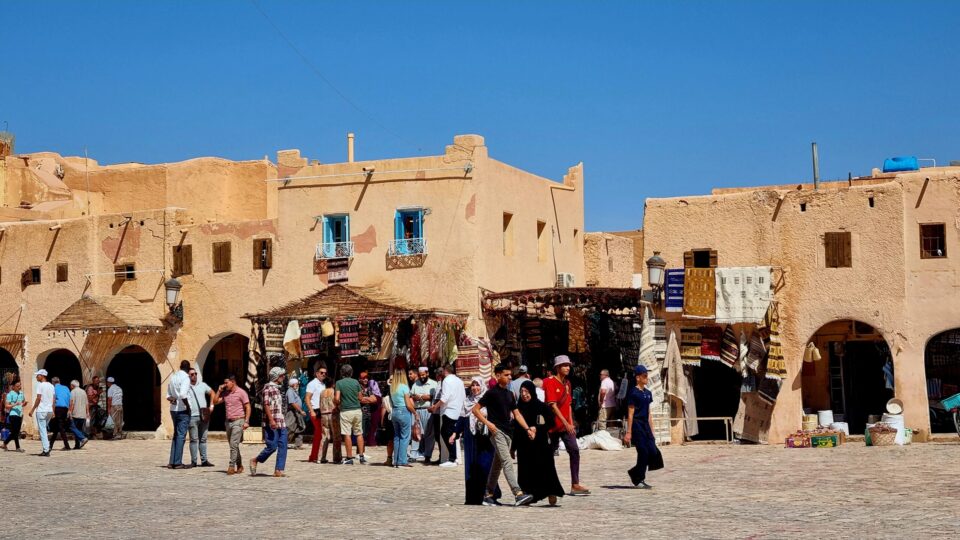
Timimoun
The arrival in Timimoun, another city in an oasis, was accompanied by a sandstorm, because of which we replaced lunch under tents with one in the private house of our friendly hosts. The city is famous for its large desert fortress (ksar) located a few kilometres away. Like all ksars with a defensive purpose, it was built on a hill above a cave, and the passages between the walls that create shade are filled with orange-red Sahara sand.
An evening trip to the nearby dunes also brought us a big surprise. Thousands of people gather there before sunset so that, once the sun goes down, they start a procession, which we learned is religious. Believers traditionally gather for evening prayers on the occasion of the Prophet Muhammad’s birthday, which was celebrated just as we were visiting. In cities, this is usually in mosques, but people gather on the dunes in the desert, where life depends on nature and its temper. When several columns of worshipers join together in the central valley between dunes, singing and dancing, they take the prayer position towards Mecca, and the worship begins.
We sit on the floor at low tables, and the hosts first serve us dates and then bring out soup, couscous with meat and vegetables, and fruit
The next day, the national airline Air Algérie took us back to the capital, where we all went home. All of us were without the bottles filled with sand that we collected on the dunes, but on the other hand, full of impressions and nice words about our hosts. Immense kindness and friendliness, the desire to help or to talk with you, make you feel extremely welcome and safe. Lunch accompanied by traditional Arabic love songs and dancing accompanied by screams gave a special touch to the stay in Algeria.
While more serious development of tourism in Algeria requires time, it is undeniable that the government is doing a lot to improve and promote it. Traditionally hesitant due to their difficult historical struggle for freedom and the abolition of the colonial system, Algerians still feel the need to leave nothing to chance, which is one of the obstacles to tourism development. Independent travellers and tourists sometimes have to research on their own and wander around to get immersed in the residents’ way of life.
In the hope that Belgrade and Algeria will soon be connected by a direct route (the flight would take a little over two hours), we invite you to visit this beautiful country of good people.
